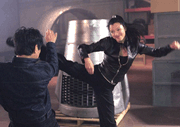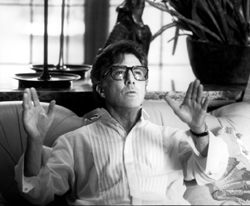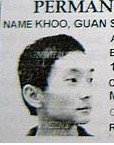Cradle 2 The Grave (2003)
Straight to the grave
A poor excuse for a movie. Not only did famed martial artist & movie star Jet Li take a backseat in the screenplay, despite having first billing (or at least 'left' billing on the movie poster), but the tone of the movie was lethargic. I blame the casting and  performance of a Earl Simmons, also known as Dark Man X or the abbreviation DMX. His acting ability as a small-time crook & doting father, Fait, falls short in substance & credibility. Had he persuaded the audience with an angry bark here & an expressive growl there, and had the filmmakers made a final cut with a sense of humour, "Cradle 2 The Grave" would have amused. If this warning of imminent sleep-inducement proves inadequate, do read on.
performance of a Earl Simmons, also known as Dark Man X or the abbreviation DMX. His acting ability as a small-time crook & doting father, Fait, falls short in substance & credibility. Had he persuaded the audience with an angry bark here & an expressive growl there, and had the filmmakers made a final cut with a sense of humour, "Cradle 2 The Grave" would have amused. If this warning of imminent sleep-inducement proves inadequate, do read on.
The plot: Fait, a fellow henchman, a stripper (Gabrille Union), and a semi-getaway man (Anthony Anderson) attempt a diamond heist &, in the process, lifted a bag of black stones that look like really expensive licorice candy. The dark gems spell trouble & our team of supposedly likeable robbers get caught in a triangle of made-in-Taiwan predicament; a Chinese supercop, Su (Jet Li) deployed on search & retrieve, a former Chinese guy (literally, since he looks rather half-Caucasian), Ling (Mark Dacascos), who's bumped into Su in the past, with black-market auction in mind, & a kingpin-like mobster are all after the stones in this contrived, over-cooked noodle plot. Eventually, the supercop teams up with Fait & his band of "mean-streeters" and together they battle dogs, men in cages, expendable crewmen and attempt to rip-off selected members of the underworld. A subplot involves a rather cheesy & sugary relationship between Fait & his pre-teen daughter who vexes her kidnappers with stereotypical "rugrats" antics. Further, Tom Arnold was used as a character actor who manufactures stale jokes using his fumbling sidekick persona so effectively employed in Cameron's "True Lies".
To sum up, "Cradle 2 The Grave" is a disappointing Jet Li actioner that doesn't live up to the promise of hip-hop intensity suggested in the title. 2 bad. Anthony Anderson did steal the show with his on-the-job comical turns as a team member who goes to over-the-top lengths as a professional con-man. He should have been the lead character "buddy" to Jet Li's stoic Su.
DMX's protagonist of Fait is more minimal than minimalist; the filmmakers allowed him to get away with acting & mumbling like the average heroic fellow. Kelly Hu's catty female sidekick to the villain has the appropriate mean, razor-sharp looks, but, unfortunately, the screenplay eventually furnishes her character with dialogue. Jet Li still delivers some entertaining moves, particularly his signature "offensive blocks" where he would strike an enemy's blow, either punch or kick, with its equivalent. Ultimately, the film that takes itself seriously, could have been saved had the director made it into a very marketable comedy action flick like the Tucker-Chan "Rush Hour" series. http://us.imdb.com/title/tt0306685/



